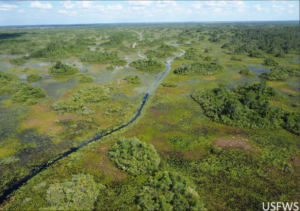With tips and actions to help you join us.
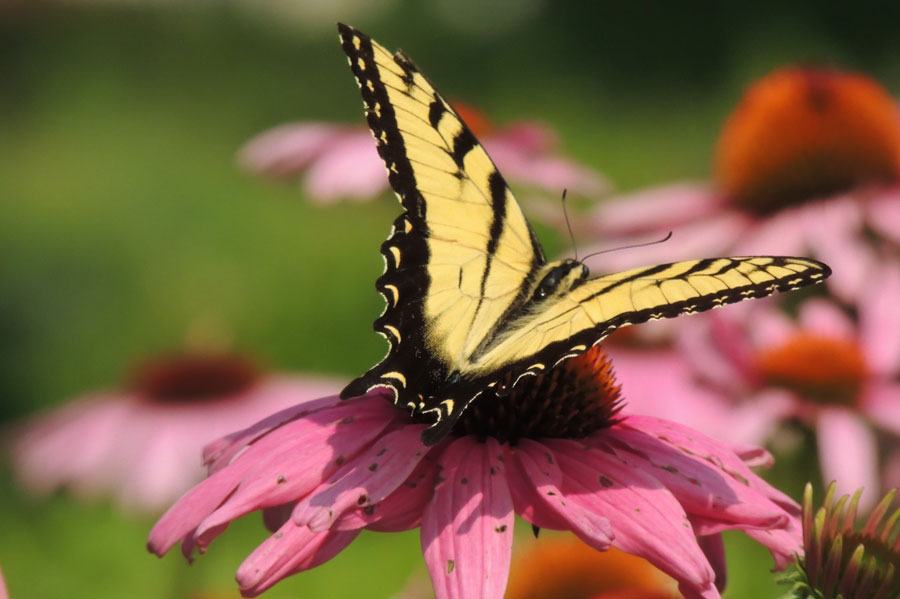
Photo by Sr. Samuel Holowacz
1. Show Reverence for Nature
“If you really care for something, you won’t harm it,” says Sr. Mary Jean Sliwinski. “We need to get to the point of really caring for the earth.” Sr. Jean describes a butterfly she saw in her mother’s yard in Buffalo, NY – a female Eastern black swallowtail. This creature has brilliant black wings with a double row of white spots at the edges and striking royal blue markings near the tail. A little bit of research told her that black swallowtails are very fond of dill, which her mother was growing to make pickles. Watching the butterfly and admiring her beauty led to understanding and then preserving her habitat. Sr. Jean supports local pollinators at her convent garden; her vibrant pink turtleheads, yellow black-eyed Susans, and red cardinal flowers attract butterflies and hummingbirds, while the white bloodroot brings small bees, wasps, and ants. These, along with coneflowers, hollyhocks, rose of Sharon, and other native plants, sustain an ecosystem and beautify the neighborhood. As she tends her garden, neighbors or parishioners often stop to admire, creating opportunities for Sr. Jean to help people connect with nature. She says, “Catholic social teaching has included care for the environment for the last 100 years, but most of us haven’t paid attention. We need to go deeper and get that care for creation into our spirituality.”
What You Can Do
If you have a lawn, consider taking part in “No Mow May,” a movement that has spread through 30 U.S. cities. Letting your lawn grow longer in the spring can help bees and other pollinators thrive.
Try planting native pollinators. The Audubon Society can help you learn which species are native to you, with a zip code tool on their website: audubon.org.
Use natural pesticides instead of harmful chemicals.
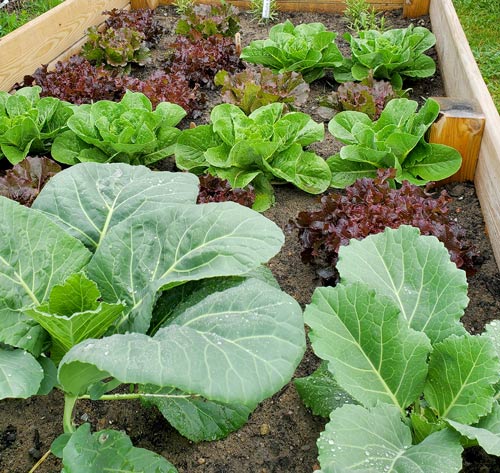
2. Choose Food Responsibly
In convents around North America, Felician Sisters think about how the food choices they make impact the planet. Sr. Mary Dorothy Young in Las Cruces, NM, tries to make sustainable choices. “We eat some meat,” she reports. “But not a lot.” They make protein smoothies in the morning with plant-based protein and fresh or frozen fruit, and they enjoy local Mexican dishes such as bean tostados with cabbage and tomatillos. Around the province, sisters read grocery labels to find out where their food comes from – and they try to buy seasonal produce. In Buffalo or Detroit, for example, they might forgo strawberries in winter to avoid the large carbon footprint of fruit that has travelled all the way from South America. During the growing season, some sisters tend their own vegetable gardens and donate overabundant cucumbers, tomatoes, zucchini, beans, peas, and beets to local food pantries.
What You Can Do
If you have a garden, consider donating some of your fresh produce to a local food bank.
Read labels at the grocery store, and decrease your carbon footprint by not buying out-of-season produce shipped across great distances.

3. Dress for (Planetary) Success
Whatever they wear, Felician Sisters make clothing choices that are good for the planet. They repair rather than replace their clothes, resisting “fast fashion” in favor of dressing simply. Provincial Minister Sr. Judith Marie Kubicki points out the array of social justice issues connected to clothing consumption, from just wages for textile workers around the globe, to the environmental damage caused by the fashion industry’s use of toxic chemicals. Sr. Rosemarie Goins, in San Antonio, TX uses her sewing skills to show kindness to the planet. “I have some stuff I’m still wearing from the 70s and 80s,” she reports. In convents around North America, Felician Sisters take a sensible approach to wardrobe issues. “If we get too fat or too skinny or the elastic gives out, we just put a new band on our skirt,” Sr. Rosemarie says. “If a hem comes out, we fix it.” When they do need to replace an article of clothing, they often shop at thrift stores or resale shops rather than buying new clothes.
What You Can Do
Next time you are tempted to go shopping for new clothes, think about whether you could repurpose something already in your closet.
When you do go shopping, read labels to find out where your clothing is made.
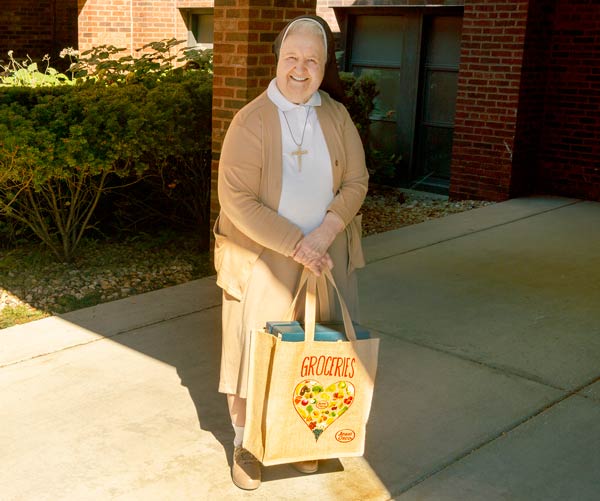
4. Consume Thoughtfully
Ever careful to avoid single-use plastics, Felician Sisters use refillable water bottles, pack utensils with their lunches, and carry cloth bags to the grocery store. In Las Cruces, NM, Sr. Mary Dorothy Young appreciates that the roadsides are less unsightly, thanks to a New Mexico ordinance that bans plastic bags in grocery stores. Sr. Dorothy Ann Mary Moczygemba in San Antonio, TX, points out that recycling after a meal is another important component of mindful food consumption. Following a recent middle school retreat, she recycled 57 empty pizza boxes, not only repurposing the cardboard, but also saving the multiple 40-gallon trash bags that otherwise would have been used to dispose of the empty pizza boxes. All around the province, Felician Sisters reuse, repair, and recycle.
What You Can Do
Carry reusable bags when you run errands, to avoid using plastic bags.
Check your community’s recycling guidelines and epa.gov to learn more about what and where you can recycle.

5. Get Filled with (Renewable) Energy
When the Felician Sisters began their solar project, they did so with the understanding that a community cannot talk about protecting the environment unless they are willing to “walk the walk.” The Province House in Beaver Falls is now a visible reminder of the sisters’ commitment to sustainable energy. Solar panels along the road provide 80% of the energy used in the house. Province-wide, the sisters have a 2-megawatt solar array on 6 sites in 5 states that has, to date, produced 13 gigawatts of power, keeping 7,837 tons of CO2 out of the atmosphere and producing enough power to charge 544,198 electric cars. Immaculate Heart of Mary Convent in Buffalo uses geothermal energy, while Mother of Good Counsel Convent in Chicago produces hot water with solar energy. The convent and school at Our Lady of the Sacred Heart in Coraopolis, PA are LEED-certified. Along with building-wide or province-wide energy initiatives, sisters make mindful choices about energy in their day-to-day lives. During the winter, they lower thermostats at night, and they limit air conditioning use in the summer. Small modifications can add up to big differences. When bathroom fixtures put out more light than they need, the sisters simply unscrew some of the bulbs in order to save precious electricity and do their part to save the planet.
What You Can Do
Share with us some creative ways that you save energy?
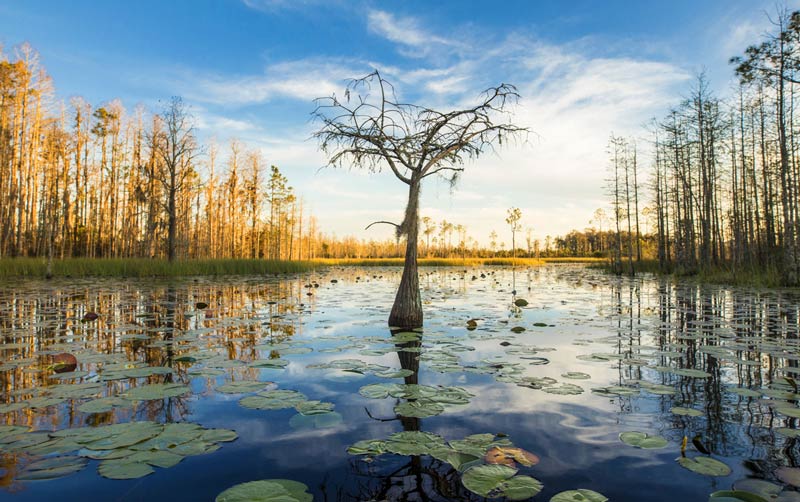
6. Invest in a Greener Future
Sr. Mary Jean Sliwinski serves on the board of the Interfaith Center on Corporate Responsibility, which engages in respectful dialogue with corporations and has a real impact. She proudly touts investments in water quality, renewable energy, organic agriculture, and other sustainable practices. In 2021, the Okefenokee National Wildlife Refuge in southern Georgia (designated for conservation in 1937 and home to more than 600 plant species and 400 animal species) was threatened by a potential mining project. Sr. Jean worked swiftly with Green Century Capital Management, an environmentally responsible investment firm, to file a shareholders resolution to Chemours, asking them to never operate or profit from the proposed Twin Pines mine. In response to this proposal, Chemours stated it has no current or future interest in buying the proposed Twin Pines Minerals, LLC mine. Chemours announced a further commitment to “ensure the value of the Okefenokee is maintained” and made it clear that it has no plans to mine next to the refuge. Having scored a notable victory for environmental justice, Sr. Jean and the Felician Sisters will continue to vigilantly monitor activities that threaten our natural world and raise their voices in defense of the earth using every resource in their power.
Read Okefenokee Swamp “Victory.”
What You Can Do
Join the Laudato Si’ Action Platform. Together, we can take action to care for our common home.



